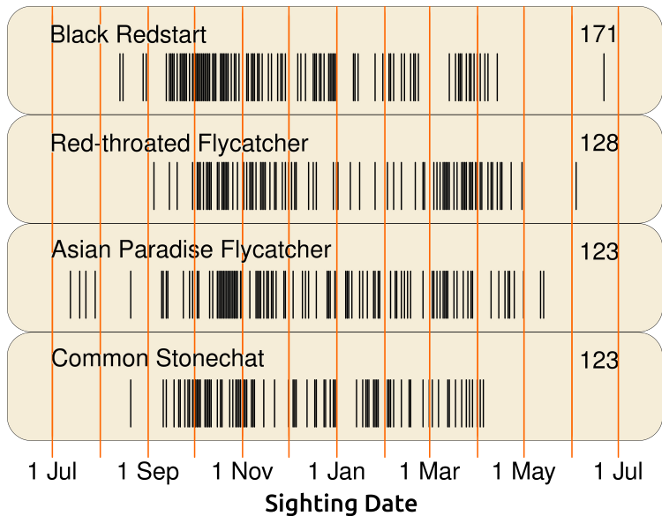Tuesday, 15 April, 2014
GBBC 2014 was a record event for India! Over 1,100 birders participated, contributing more than 3,000 lists, which contain observations of 823 species — this is the largest number of species contributed to the GBBC by any country in the world!
Visit this link to see the results for GBBC India, lists of participants, and other interesting details.
Many thanks to all who contributed! But the story doesn’t end with GBBC. Here is an exciting activity for all of us to take part in — the eBirding Challenge for India — which started on 1 April 2014, and will continue all through the year.
Friday, 7 June, 2013
In continuation with our presentation of present arrival patterns of our most-reported species, we now feature Black Redstart, Red-throated Flycatcher, Asian Paradise Flycatcher and Common Stonechat.
As in previous summaries each sighting is shown as a vertical black line.

It is apparent from the above chart that Black Redstart and Common Stonechat arrive in mid-September and generally leave by March-end. Red-throated Flycatchers arrive slightly in late September and return by April-end. The Paradise Flycatcher, which is an intra-subcontinental migrant, has records spread over the entire year. (Please note that this summary has only been possible thanks to your contributions!)
Saturday, 11 May, 2013
Here we present arrival patterns of some of the most-reported species: the Barn Swallow, Brown Shrike, White Wagtail and Western Yellow Wagtail.
Like in previous summaries each sighting is shown as a vertical black line.

As you can appreciate from the above illustration, Barn Swallows and Brown Shrikes arrive around late July/early August and nearly all of them leave by April. The wagtails normally arrive in early September and usually are gone by April-end. (This summary has only been possible thanks to your contributions!)


